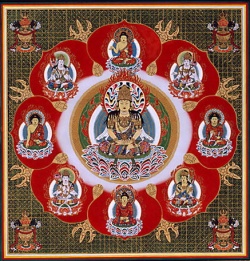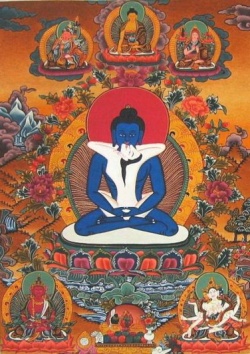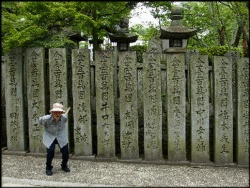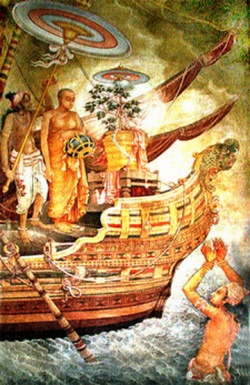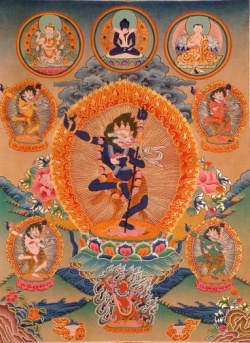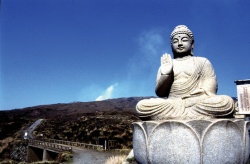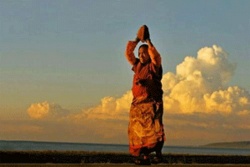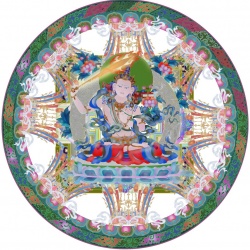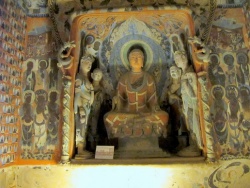The Inner Kālacakratantra - A Buddhist Tantric View of the Individual: A History of the Ṣaḍ-aṅga-yoga of the Kālacakratantra and Its Relation to Other Religious Traditions of India
The Inner Kālacakratantra
A Buddhist Tantric View of the Individual
A. Wallace
A History of the Ṣaḍ-aṅga-yoga of the Kālacakratantra and Its Relation to Other Religious Traditions of India
A close look at the Kālacakratantra's six-phased yoga reveals its correlation and historical connection to earlier forms of the six-phased yoga, found in both Hinduism and Buddhism. Moreover, it also reveals the unique character of the practical applications and implications of the Kālacakratantra's sixphased yoga. To the best of my knowledge, the earliest reference to a six-phased yoga is found in the Maitrāyaṇīya, or Maitrī Upaniṣad, which belongs to the branch of the black Yajur Veda and is considered to be the last of the classical Upaniṣads. The ṣaḍ-aṇga-yoga of the Maitrāyaṇīya Upaniṣad, Ch. 6, v. 18, contains the following six phases: breath-control (prāṇāyāma), retraction (pratyāhāara), meditative stabilization (dhyāna), concentration (dhāraṇā), contemplative inquiry (tarka), and samādhi. [1] It is taught in this Upaniṣad as a method for achieving union with the supreme Self (paramātman).
If we accept that the Maitrāyaṇīya Upaniṣad predates Patañjali, we can assume that this six-phased yoga also predates the eight-phased yoga (aṣṭāṅga-yoga) of the classical Yoga system. The fact that Patañjali never makes any reference to a six-phased yoga and that his Yogasūtra never mentions contemplative inquiry (tarka) is not sufficient evidence to regard the six-phased yoga as a later revision of the eight-phased yoga, as Günter Grönbold suggests. [2] Even if the sixth chapter of the Maitrāyaṇīya Upaniṣad, which incorporates a six-phased yoga, is a later interpolation, as Mircea Eliade speculates, [3] the antecedence of the sixth-phased yoga to the yoga of Patañjali is still quite plausible. The phrase “for it is said elsewhere, ” which often occurs at the beginning of the verses of the sixth chapter, indicates that the Maitrāyaṇīya Upaniṣad draws its yogic elements from the earlier yogic sources. Even though we are unable to determine the exact sources of the yogic elements in the Maitrāyaṇīya Upaniṣad, it is obvious that different forms of its six-phased yoga have very early origins in India. The six-phased yoga was later modified into diverse forms of yoga with varying numbers of phases.
For example, in one of the earliest Purāṇas, the Vāyu Purāna, Ch. 10, v. 76, [4] one enounters a fivephased yoga, whose fifth phase is recollection (smaraṇa), corresponding in name to the fifth phase of the Kālacakratantra's six-phased yoga. In this Purāṇa as in the Kālacakratantra, contemplative inquiry (tarka) is replaced by recollection. Considering that the Purāṇas underwent many revisions after the majority of their material was composed during the Gupta reign (c. 320 —c. 500 CE), it is extremely difficult to establish whether the recollection phase of yoga was established first in the Purāṇic tradition or in the Buddhist tradition, specifically, in the Guhyasamājatantra, which some scholars date as early as the fourth century ce and some as late as the eighth century CE.
Within later Hindu sources, a six-phased yoga is also mentioned in a number of texts belonging to the Upaniṣads of the Yoga class—specifically, in the Amṛtabindu Upaniṣad—and in the Śaiva Āgamas, Śaiva tantras, and some Dharma Sūtras, where there is a slightly different order of phases than that found in the six-phased yoga in the Maitrāyaṇīya Upaniṣad. For example, in the Amṛtabindu Upaniṣad, v. 6, the six phases of yoga are retraction (pratyāhāra), meditative stabilization (dhyāna), breathcontrol (prāṇāyāma), concentration (dhāraṇā), contemplative inquiry (tarka), and samādhi. This particular sequence of the phases of yoga is almost identical to that of the Kālacakratantra.
The difference between the two lies in the designation of the fifth phase of yoga as contemplative inquiry (tarka) instead of recollection (anusmṛti). [5] Even though contemplative inquiry is not explicitly mentioned among the six phases of the Kālacakratantra's six-phased yoga as a separate member, it is not absent from there. Rather, it is included within the phase of meditative stabilization (dhyāna), along with wisdom (prajñā), analysis (vicāra), joy (rati), and immutable bliss (acalasukha). [6] Contemplative inquiry as a constituent of the phase of meditative stabilization is explained in the Vimalaprabhā as the apprehension of the phenomenon of empty form that is being observed or meditated upon during this phase. [7] As such, it is an indispensable element in the practice of the Kālacakratantra's six-phased yoga.
Nevertheless, it is not given superiority over all other phases of the six-phased yoga and their elements as it is in Kaśmīr Śaivism—specifically, in the Śaivāgamas and in the works of Abhinavagupta and Jayaratha. Abhinavagupta (975–1025) in his Paratrīśikavivara asserts that “among all the lights of the component parts of yoga, ” contemplative inquiry (tarka) has already been determined in the earlier Mālinīvijaya “to be the brilliant sun by which one gets liberated and liberates others. ” [8] When commenting on Abhinavagupta's Tantrāloka, Jayaratha (thirteenth century) in his Tantrālokaviveka mentions the six-phased yoga that has breath control (prāṇyāma) as its first member and contemplative inquiry (tarka) as its fifth member and exalts it as the highest (uttama) phase. [9] Moreover, just as contemplative inquiry is included in the six-phased yoga of the Kālacakratantra, even though it is not regarded as a separate phase, so too are meditative posture (āsana) and restraint (niyama) implicitly included in this yoga. The vajra-posture (vajrāsana) is often referred to as the posture in which an adept of the Kālacakratantra does his meditative practice, whereas niyama is included in the observance of the Kālacakratantra's ethical discipline, in the form of restraint from indulging in the five objects of desire and keeping the twenty-five tantric precepts (vrata), which are deemed prerequisites for the successful outcome of the practice of the six-phased yoga. [10] The Vimalaprabhā defines niyama as a Buddha's command (buddhānujñā) with regard to the twenty-five precepts. [11] Since these two prerequisites to the Kālacakratantra's six-phased yoga are present in each phase of the yoga as qualifying conditions, they are not considered to be separate phases. Within later Hindu sources there are also those who speak of a six-phased yoga that does not include the phase of contemplative inquiry but includes meditative posture (āsana) as the first phase. For example, some Yoga Upanisads—specifically, the Dhyānabindu Upaniṣad, v. 41 and the Yogacūḍāmaṇi Upaniṣad, v. 2—several texts of the Gorakṣa corpus (c. twelfth century), and the Netratantra, cited in Kṣemarāja's Vimarśinī (eleventh century) commentary on the Śiva Sūtra 6, contain the following list of the six phases: posture (āsana), breath-control (prānāyāma), retraction (pratyāhāra), meditative stabilization (dhyāna), concentration (dhāraṇā), and samādhi. This form of the six-phased yoga seems to be later than that found in the Guhyasamājatantra and later incorporated into the Kālacakratantra.
Thus, it is most likely that the Buddhist six-phased yoga chronologically succeeds the six-phased yogas containing contemplative inquiry (tarka) as the fifth phase, which continued to be in practice in later times as well. However, it is more difficult to determine with certainty whether the Buddhist six-phased yoga precedes the six-phased yoga of Kaśmīr Śaivism that contains meditative posture (āsana) as its first phase or whether it was contemporaneous with it. If one were to rely only on the extant Śaiva texts that refer to the sixthphased yoga having meditative posture as its first member, it would seem that the Buddhist sixth-phased yoga preceded that particular yoga of Kaśmīr Śaivism. Considering the incompleteness of textual and historical information, it is impossible to reconstruct an accurate and precise history of the six-phased yoga in India. Therefore, I offer here only a limited comparative table of the different types of six-phased yogas that were cited in specific Śaiva, Vaiṣṇava, and Buddhist texts.
As table 2.1. indicates, not only teachers of different religious traditions but also various teachers of different schools within the same tradition taught diverse forms of the six-phased yoga, according to their intended goals. Even though these diverse types of the sixphased yoga were couched within the different theoretical and practical frameworks of disparate traditions, they all share some commonalities. The most salient point of commonality is that each form of the six-phased yoga is viewed within its own tradition as inducive to the accomplishment of both limited, or mundane, and supreme siddhis. There are also certain commonalities in the more general interpretations of some phases of the diverse types of six-phased yoga, despite the clear divergence in the manner in which particular phases are structured and practiced within the different traditions.
For example, in both Kaśmīr Śaivism and Buddhism, the phase of breath-control (prāṇāyama) involves bringing the prānas into the central nāḍī phase of retraction (pratyāhāra) involves the withdrawal of the senses from external objects; and meditative stabilization (dhyāna) implies meditation on a divine form, and so on. Their interpretations also coincide to a certain degree with Patañjali's definitions in the Yoga Sūtras. For the variant listings of the six members of the ṣaḍ-aṇgayoga within the different schools of the Hindu and Buddhist traditions see table 2.1. Within the Indian Buddhist tradition, teachings on the six-phased yoga are found within two Buddhist tantric systems—the Guhyasamājatantra and the Kālacakratantra. The Hevajratantra (Ch. 8, vs. 21– 22) also mentions a six-phased yoga, but it does not list its members nor does it elaborate on it. Even though the six-phased yogas of the Kālacakra and Guhyasamāja systems accord in the names and in the sequences of their phases, they differ in their content and practical implications. Among the Indian sources of these two traditions, the majority of treatises and commentaries on the six-phased yoga belong to the Kālacakra corpus.
According to the Blue Annals, the six-phased yoga of the Kālacakratantra was initially taught by Vajradhara in the form of Avadhūtipa to Anupamarakṣita (c. eleventh-twelfth centuries), who passed it on to his friend Śrīdhara. [12] Two works on the six-phased yoga are traditionally attributed to Anupamarakṣita: the ṣaḍaṅgayoga and the ṣaḍaṅgayoganāma. The later Indian author Raviśrījñāna (eleventh-twelfth centuries)—in the introductions to his Guṇabharaṇī, a commentary on the ṣaḍaṅgayoga and to his ṣaḍaṅgayogaṭīkā, commentary on the ṣaḍaṅgayoganāma—gives a brief account of Anupamarakṣita's revelatory experience. [13] According to the accounts recorded in the Guṇabharaṇi and the ṣaḍaṅgaṭīkā, Anupamarakṣita studied Buddhism and other Indian systems of thought. Under the guidance of Śrīkhasarpana, he practiced for twelve years a meditation on reality without an object and free of conceptualizations, but was unable to gain a special insight. Depressed, he fell asleep, during which Vajrayoginīappeared to him, instructing him to go to Vikramapura, where he would attain that special insight. After arriving at midnight in Vikramapura—accompanied by his disciple, the great paṇḍita Śrīdhara——Anupamarakṣita received instruction on the six-phased yoga directly from the Buddha in the form of Avadhūta. By merely receiving the instruction that confirmed, “This is reality, ” he entered samādhi; and upon emerging from his samādhi in the early morning, Anupamarakṣita taught this knowledge to Śrīdhara. With some variations, this story is repeated several times in later Tibetan chronicles of Buddhism and the lineage of the Kālacakratantra's six-phased yoga. [14] Apart from Padma dkar po, who mistook Vikramapura for Vikramaśīla monastery in Bihar, none of the sources specify the location of Vikramapura nor the place from which Anupamarakṣita went to Vikramapura. It is likely that the Vikramapura to which Raviśrījñāna refers is Vajrayoginī village in contemporary Dacca, located in east-central Bengal, which is also thought to be the birthplace of Atīśa. [15] This is perhaps the same Vikramapura mentioned in the inscriptions found in north India. In the inscriptions related to the rulers of the Varman and Vikramāditya dynasties of northern India, Vikramapura is mentioned as their capital during the eleventh and twelfth centuries.
The Varman dynasty ruled eastern Bengal in the second quarter of the eleventh century, and their Vikramapura was eventually overtaken by Vijayasena, the greatest king of the Sena dynasty, in the middle of the twelfth century. Thus, Raviśrījñāna, who, according to Tāranātha's History of Buddhism in India, lived during the reign of the Sena dynasty, could have been referring to that Vikramapura. [16] Some inscriptions mention Vikramapura as a capital founded by Vikramāditya VI (c. 1076–1126). His father, Someśvara I, reigned in Magadha and eastern Bengal, and he himself conquered central Bengal shortly before 1068 ce, after defeating Vigrahapāla III. According to Tāranātha's History of Buddhism in India, Anupamarakṣita lived during the period of the Bhayapāla and Nayapāla kings of the Pāla dynasty. [17] Nayapāla, the father of the mentioned Vigrahapāla III, ascended the throne in the early eleventh century and ruled the kingdom that extended on the west up to Bihar and to the east to central Bengal. Tāranātha's information coincides with '[[Gos lo tsa ba gzhon nu dpal's assertion in the Blue Annals that Anupamarakṣita could not have been later than Nāro (956–1040 ce), since Nāro cites Anupamarakṣita's teaching in his Sekkodeśaṭīkā. [18]
Thus, whether Raviśrījñāna was referring to the Vikramapura of the Pālas, Varmans, or Vikaramādityas, according to Buddhist tradition the Kālacakratantra's six-phased yoga was first disseminated in Bengal. Anupamarakṣita's name could have been easily related to the well-known Anupama monastery (vihāra) in Kaśmīr, which produced Buddhaśrījñāna, Sarvajñaśrīrakṣita, and Śākyaśrībhadra, the great early eleventh-century Kaśmīr scholars of the Kālacakratantra. His name also could have been related to Anupamapura, the seat of the two greatest Buddhist centers of learning in Kaśmīr during the eleventh and twelfth centuries—the monasteries of Ratnagupta and Ratnarāśmi. In either case, Anupamarakṣita could have come to Bengal from Kaśmīr. It is clear from the extant Indian and Tibetan sources that there were several lineages of the Kālacakratantra's six-phased yoga in India.
As these sources indicate, the most important among those lineages was that of Anupamarakṣita. In the Guṇabharaṇī, Ravis´rījñāna gives the following lineage: Anupamarakṣita [19] —Śrīdhara— Bhāskara—Ravis´rījñāna. The same lineage, but in an extended form, is also given in the Blue Annals, the fifteenth-century Tibetan chronicle of Buddhism in Tibet, which also mentions the famous lineages of Indian Buddhist masters. According to the Blue Annals, the most famous lineage of the Kālacakratantra's six-phased yoga in
India begins with Anupamarakṣita and ends with the Bengali mahā-paṇḍita, Vanaratna (1384–1468). Vanaratna received the transmission of the six-phased yoga from the mahā-siddha Śavaripa, one of the eighty-four legendary mahā-siddhas of India, and he taught it extensively in Tibet during the first half of the fifteenth century. [20] The extended lineage is given as follows: Anupamarakṣita— Śrīdharanandana (Sādhuputra) [21] —Bhāskaradeva—Raviśrījñāna (Sūryaśrī)—Dharmākāraśānti— Ratnarakṣita— Narendrabodhi—Muktipakṣa—Śākyarakṣita—Sujata—Buddhaghoṣa—Vanaratna. The exact same lineage of Indian masters is also mentioned in Padma dkar po's (sixteenth century) Dpe med 'tsho'i lugs kyi rnal 'byor yan lag drug pa'i khrid rdo rje'i tshig 'byed. [22] Earlier Tibetan historians of Buddhism in India and Tibet recorded a shorter branch of Anupamarakṣita's lineage in India.
In his Dpe med 'tsho'i sbyor drug gi br gyud pa, included in the Gsang sngags rgyud sde bzhi'i gzungs'bum, [23] Bu ston offers the following list for the Indian masters following the lineage of Anupamarakṣita: Anupamarakṣita—Śrīdhara—Bhāskaradeva—Dharmākaras ´ānti—Ravis´rījñāna— Ratnarakṣita—Vibhūticandra. This line of Indian Buddhist masters ends with Vibhūticandra (twelfth—thirteenth centuries). According to Padma gar dbang, [24] Vibhūticandra received his Kālacakratantra initiation and teachings from three Indian scholars: Śākyaśrībhadra, the mahā-paṇḍita of Kaśmīr, [25] who was his principal spiritual mentor, Vikhyātadeva, and Dharmadāsa. In Nepal, he mastered the Kālacakratantra under the guidance of Ratnarakṣita, the Newari mahāpaṇḍita, from whom he received the teachings of the six-phased yoga of the Kālacakratantra in the tradition of Anupamarakṣita. During his stay in Nepal, Vibhūticandra became an expert in the Kālacakratantra and in the practice of the six-phased yoga. According to Padma gar dbang, [26] he wrote annotations to the Kālacakratantra and the Vimalaprabhā, which influenced later Tibetan translators and commentators on the Kālacakratantra.
As one of the Indian mahā-paṇḍitas, Vibhūticandra visited Tibet three times and became fluent in the Tibetan language. He himself translated his ṣaḍaṅgayoganāma (Rnal 'byor yan lag drug pa) [27] into Tibetan. According to the Tibetan six-phased yoga tradition, the ṣaḍaṅgayoganāma is the direct transmission of the six-phased yoga practice that Vibhūticandra received from Śavaripa during his stay at Stham Bihar monastery in Kathmandu, upon which he attained dhāraṇā, the fourth phase of this yoga. In subsequent centuries, this text became one of the most important and authoritative texts for the direct transmission of the Kālacakratantra's sixphased yoga in Tibet, especially in the Jonangpa tradition. According to Tāranātha, [28] the teachings on the six-phased yoga that Śavaripa revealed to Vibhūticandra were based on the dohas of Saraha, and Saraha's yogic practice itself was based on the six-phased yoga. In the Sbyor ba yan lag drug gi rdzogs rim gyi gnad bsdus pa, Tshong kha pa [29] (fourteenth—fifteenth centuries), following his teacher Bu ston, cites the Indian lineage of Anupamarakṣita in this way: Anupamarakṣita—Śrīdhara—Bhāskaradeva— Dharmākaraśānti—Raviśrījñāna—Ratnarakṣita — Vibhūticandra.
Footnotes
- ↑ The Maitrāyaṇīya Upaniṣad, Ch, 6. v. 18: tathā tatprayogakalpaḥ prāṇāyāmaḥ pratyāhāro dhyānaṃ dhāraṇā tarkaḥ samādhiḥ ṣaḍaṅgā ity ucyate.
- ↑ See Günter Grönbold, The Yoga of Six Limbs: An Introduction to the History of ṣaḍaṅgayoga, 1996, p. 11.
- ↑ See Mircea Eliade, Yoga: Immortality and Freedom, 1969, p. 125.
- ↑ The Vāyu Purāṇa, Ch. 10, v. 76 reads:
- ↑ A six-phased yoga that contains contemplative inquiry (tarka) as the fifth phase is also mentioned in the Dakṣasmṛti, Ch. 7, v. 3; the Atrismrti, Ch. 9., v. 6; the Mrgendrāgama, Ch. 7, v. 5; Abhinavagupta's Tantrāloka, Ch. 4, v. 15, etc.
- ↑ The Kālacakratantra, Ch. 4, v. 116.
- ↑ The Vimalaprabhā commentary on the Kālacakratantra, Ch. 4, v. 116.
- ↑ See Abhinavagupta, A Trident of Wisdom, tr. by Jaideva Singh, 1988, p. 196.
- ↑ See N. Rastogi, The Krama Tantricism of Kashmir, 1996, pp. 59–60. Cf. the Mālinīvijayottaratantra, Ch. 17, v. 16, 1922, p. 114, which reads: “contemplative inquiry is the highest phase of yoga” (tarko yogāṅgam uttaram).
- ↑ For the explanation of niyama in the context of the Kālacakratantra, see the Vimalaprabhā, 1986, Ch. 1, p. 117, the Kālacakratantra, Ch. 3, vs. 70, 138, and 147, together with the Vimalaprabhā commentary.
- ↑ The Vimalaprabhā commentary on the Kālacakratantra, Ch. 3, v. 70.
- ↑ G. N. Roerich, tr., Blue Annals, 1988, p. 764.
- ↑ The ṣaḍaṇgayogaṭīkā was translated into Tibetan by Vibhūticandra and included in the Peking edition of the Tibetan Bstan 'gyur, vol. 47, #2084: 238.2.5. –242.4.2. It has been translated into German by Günter Grönbold, 1969. See also the Guṇabharaṇīnāmaṣaḍaṅgayoga-ṭippaṇī, half of which was initially translated into Tibetan by Vibhūticandra and is included in the Peking edition of the Tibetan Bstan 'gyur, vol. 47, #2103: 283.1.5–294.4.8.
- ↑ Roerich, Blue Annals, p. 764; Tāranātha's History of Buddhism in India, 1990, pp. 307– 308; Padma dkar po's 'Brug pa'i chos 'byung and Dpe med 'tsho'i lugs kyi rnal 'byor yan lag drug pa'i khrid rdo rje'i tshig 'byed in the Collected Works of Padma dkar po, vols. 2 (kha) and 17 (tsa); and Bu ston's Sbyor ba yan lag drug gi sngon 'gro'i rim pa in the Collected Works of Bu ston, pt. 3 (ga), 1965, p. 348.
- ↑ Several Tibetan authors such as Nag tsho, Sum pa, and others mention Vikramapura in Bengal as the birthplace of Atīśa. They speak of Vikramapura as a prosperous city with a large population. For more details see Alaka Chattopadhyaya, Atīśa and Tibet, 1996, pp. 57– 66.
- ↑ Tāranātha's History of Buddhism in India, 1990, p. 316.
- ↑ Ibid., pp. 307–308.
- ↑ See Roerich, tr., Blue Annals, 1988, p. 764.
- ↑ Anupamarakṣita's ṣaḍaṇgayoga is preserved in Tibetan translations and included in the Tibetan Tripiṭaka, Peking edition of the Tibetan Bstan 'gyur (Vibhūticandra's and Gnyal Lotsaba Mi myam zang po's translation), vol. 47, #2083:234.2.4. –238.2.5; (Dpang Lo tsa ba Dpal ldan blo gros brtan pa's translation), vol. 47, #2102:274.3.7. –283.1.5.
- ↑ Roerich, tr., Blue Annals, p. 800.
- ↑ Several works belonging to the Kālacakra corpus are ascribed to Śrīdharanandana, known also as Sādhuputra. See the Derge edition of Tibetan Bstan 'gyur, rgyud section: the Sekoddeśaṭippanī, #1352, the Śrīkālacakrasādhananāma, #1356, and the Śrīkālacakramaṇḍalavidhi, #1359.
- ↑ Collected Works of Padma dkar po, vol. 17 (tsa), 1974, p. 213.
- ↑ Collected Works of Bu ston, vol. 16 (ma), 1965, p. 4.
- ↑ Padma gar dbang's Zab chos sbas pa mig 'byed kyi chos bskor las pan che sha wa dbang phyung gi snyan rgyud rdo rje sum gyi bla ma rgyud pa'i rnam that dad pa'i rnga chen, 24 a. For the full reference, see Cyrus Stearns, “The Life and Tibetan Legacy of the Indian Mahā-paṇḍita Vibhūticandra, ” Journal of the International Association of Buddhist Studies 19.1, 1996, pp. 129, fn. 9, and 169.
- ↑ Śākyaśrībhadra wrote several commentarial works on the Kālacakratantra, which are preserved in Tibetan. The Derge edition of the Tibetan Bstan 'gyur, rgyud section, contains the following works: the Śrīkālacakra-gananopadeśa-nāma, #1384, the Sūryacandragrahaṇagaṇita, #1385, and the Pañcagraha-prthaggananopadeśa-nāma, #1386.
- ↑ Padma gar dbang's Zab chos sbas pa mig 'byed kyi chos bskor las pan che sha wa dbang phyug gi snyan rgyud rdo rje sum gyi bla ma rgyud pa'i rnam thar dad pa'i rnga chen, 24a.
- ↑ The Sadaṇgayoganāma is preserved in the Tibetan translation. See the Tibetan Tripitaka, vol. 47, 2091, 258.4.2–258.5.1.
- ↑ Tāranātha, Rdo rje'i rnal 'byor gyi 'khrid yig mthong ba don ldan gyi lhan thabs 'od brgya 'bar, 707.5–6, 456. See Stearns, “The Life and Tibetan Legacy of the Indian mahā-paṇḍita Vibhūticandra, ” Journal of the International Association of Buddhist Studies 19.1, 1996, p. 139. For a biographical sketch of Śavaripa, see ibid., pp. 139–141, fn. 46.
- ↑ Tshong kha pa, Collected Works, vol. 17, 1976, pp. 49–50.
Continue reading
- The Inner Kālacakratantra - A Buddhist Tantric View of the Individual: Preface
- The Inner Kālacakratantra - A Buddhist Tantric View of the Individual: Introduction
- The Inner Kālacakratantra - A Buddhist Tantric View of the Individual: The Broader Theoretical Framework of the Kālacakratantra
- The Inner Kālacakratantra - A Buddhist Tantric View of the Individual: A History of the Ṣaḍ-aṅga-yoga of the Kālacakratantra and Its Relation to Other Religious Traditions of India
- The Inner Kālacakratantra - A Buddhist Tantric View of the Individual: The Nature of Syncretism in the Kālacakratantra
- The Inner Kālacakratantra - A Buddhist Tantric View of the Individual: The Concept of Science in the Kālacakra Tradition
- The Inner Kālacakratantra - A Buddhist Tantric View of the Individual: The Cosmic Body
- The Inner Kālacakratantra - A Buddhist Tantric View of the Individual: The Social Body
- The Inner Kālacakratantra - A Buddhist Tantric View of the Individual: The Gnostic Body
- The Inner Kālacakratantra - A Buddhist Tantric View of the Individual: The Transformative Body
